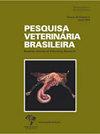在猪屠宰场检验期间,慢性胸膜病变和由此导致的胴体不符合出口资格的经济影响
IF 0.8
4区 农林科学
Q3 VETERINARY SCIENCES
引用次数: 1
摘要
摘要:慢性胸膜炎是导致生猪尸体被送往检验检疫局(DIF)的主要原因,并给养殖业和养殖户造成经济损失。屠宰后发现的大多数胸膜病变是细菌感染的后遗症,这些细菌感染不会对猪肉消费者构成风险。本研究的目的是为联邦检查局(SIF)的慢性胸膜炎评估和目的地决策提供科学的信息。因此,根据检查剂的视觉分类,对来自SIF猪屠宰场的200具胴体进行了评估,有胸膜炎和无胸膜炎。这项研究分两个阶段进行。在第1阶段,通过宏观显微镜、组织病理学和细菌培养,对50只伴慢性胸膜炎的肺病变和50只伴慢性胸膜炎病变的胴体进行评估。在第二阶段,在胸膜壁区抽取50只患有慢性胸膜炎和50只没有这种病变的猪尸体进行细菌培养和PCR。还评估了不出口这些患有慢性胸膜炎的尸体的经济影响。考虑到病变的发展阶段,宏观检查与组织学检查具有较高的相关性。无论有无邻近肺病变,均未通过胸膜拭子进行细菌分离。70%样本的分离局限于邻近肺病变,其中多杀性巴氏杆菌A型占48%,多杀性巴氏杆菌D型和猪链球菌占12%,胸膜肺炎放线杆菌占3%。5/100样品中仅检出猪链球菌DNA,与分离到活菌无对应关系。检查过程中进行的宏观评估所显示的可靠性,慢性胸膜病变中没有活菌,以及负面的经济影响表明,患有慢性胸膜炎的尸体可以进行胸膜切除,而无需送往DIF。本文章由计算机程序翻译,如有差异,请以英文原文为准。
Economic impact of chronic pleural lesions and consequent disqualification of carcasses for export during inspection in swine slaughterhouses
ABSTRACT: Chronic pleuritis is the main reason for sending pig carcasses to the Department of Final Inspection (DIF), condemnation and led to economic losses to industries and producers. Most pleura lesions detected after slaughter are sequelae from bacterial infections by agents that do not pose risks to pork consumers. The objective of the present study was to generate science-based information for decision making in the evaluation and destination of chronic pleuritis by the Federal Inspection Service (SIF). Therefore, 200 carcasses, with and without pleurisy, from a swine slaughterhouse with SIF were assessed following the visual classification of the inspection agent. The study was carried out in two stages. In stage 1, 50 carcasses with pneumonic lesions adjacent to chronic pleuritis and 50 carcasses with only chronic pleuritis lesions were evaluated, through macroscopy, histopathology, and bacterial culture. In stage 2, 50 swine carcasses with chronic pleuritis and 50 without this lesion were sampled in the parietal pleura region to bacterial culture and PCR. The economic impact of not exporting these carcasses with chronic pleuritis was also assessed. Considering the stages of evolution of the lesions, the macroscopic examination showed high correlation with the histological examination. There was no bacterial isolation through pleural swabs, regardless of the presence or not of adjacent pulmonary lesions. Isolation was restricted to the adjacent pulmonary lesions of 70% samples, with Pasteurella multocida type A found in 48% of them, followed by P. multocida type D and Streptococcus suis in 12%, and Actinobacillus pleuropneumoniae in 3%. Only Streptococcus suis DNA was detected in 5/100 samples, with no correspondence to the isolation of viable bacteria. The reliability demonstrated in the macroscopic evaluation carried out during inspection, the absence of viable bacteria in the chronic pleural lesions, and the negative economic impact suggest that carcasses with chronic pleuritis can be submitted to pleura removal, with no need of sending to DIF.
求助全文
通过发布文献求助,成功后即可免费获取论文全文。
去求助
来源期刊

Pesquisa Veterinaria Brasileira
农林科学-兽医学
CiteScore
1.30
自引率
16.70%
发文量
41
审稿时长
9-18 weeks
期刊介绍:
Pesquisa Veterinária Brasileira - Brazilian Journal of Veterinary Research (http://www.pvb.com.br), edited by the Brazilian College of Animal Pathology in partnership with the Brazilian Agricultural Research Organization (Embrapa) and in collaboration with other veterinary scientific associations, publishes original papers on animal diseases and related subjects. Critical review articles should be written in support of original investigation. The editors assume that papers submitted are not being considered for publication in other journals and do not contain material which has already been published. Submitted papers are peer reviewed.
The abbreviated title of Pesquisa Veterinária Brasileira is Pesqui. Vet. Bras.
 求助内容:
求助内容: 应助结果提醒方式:
应助结果提醒方式:


